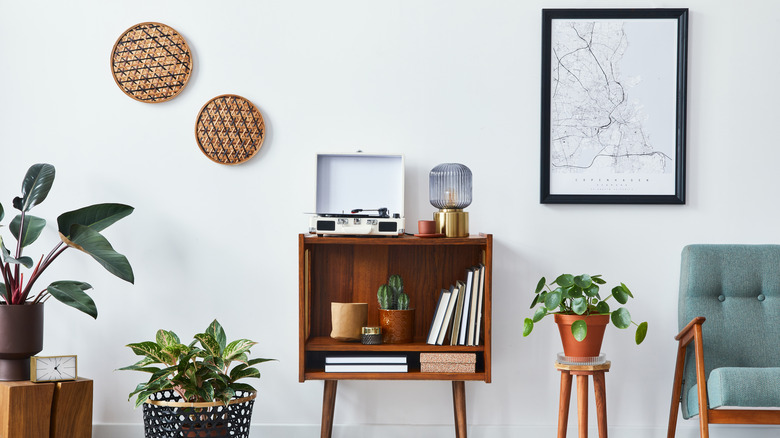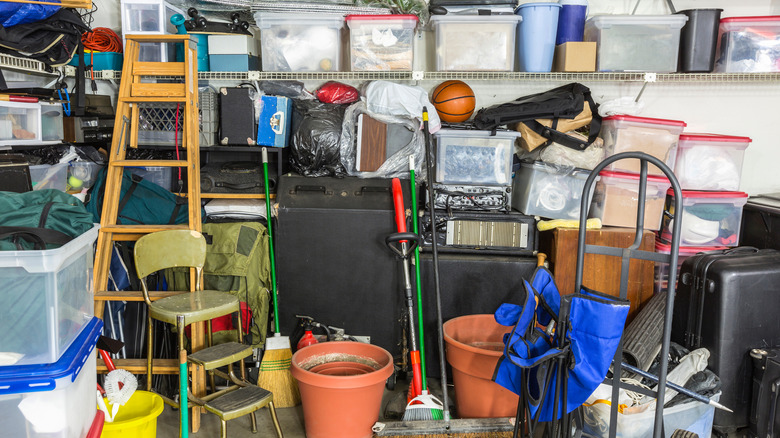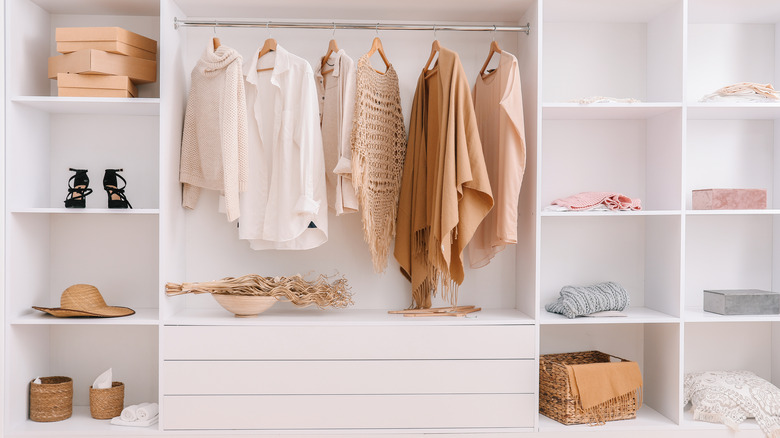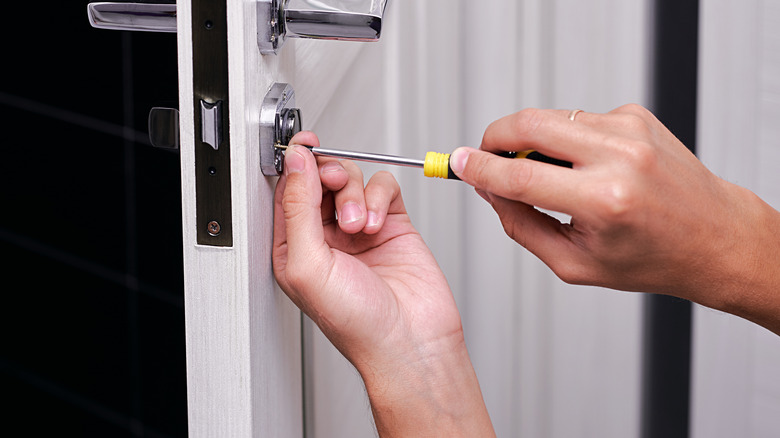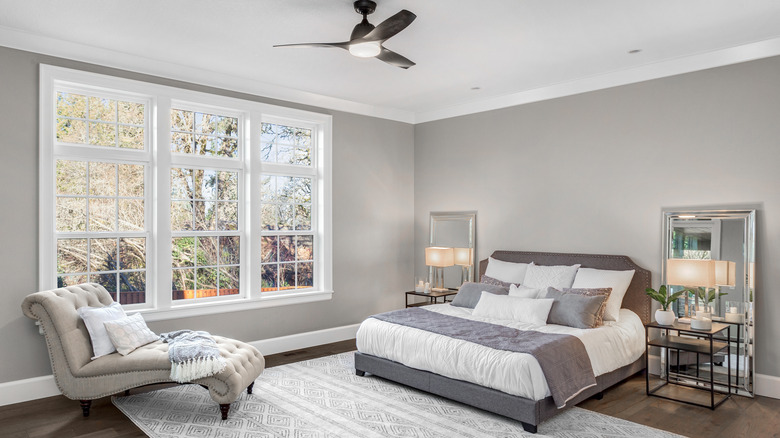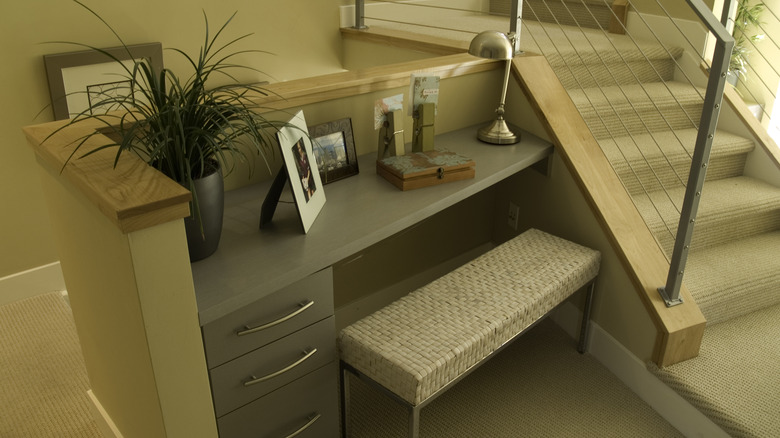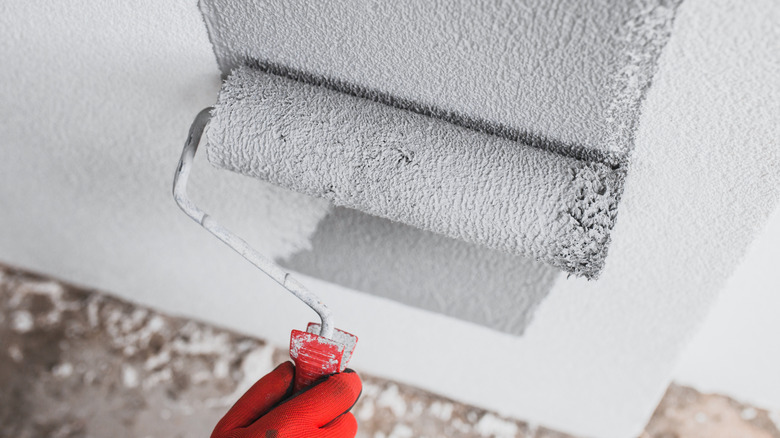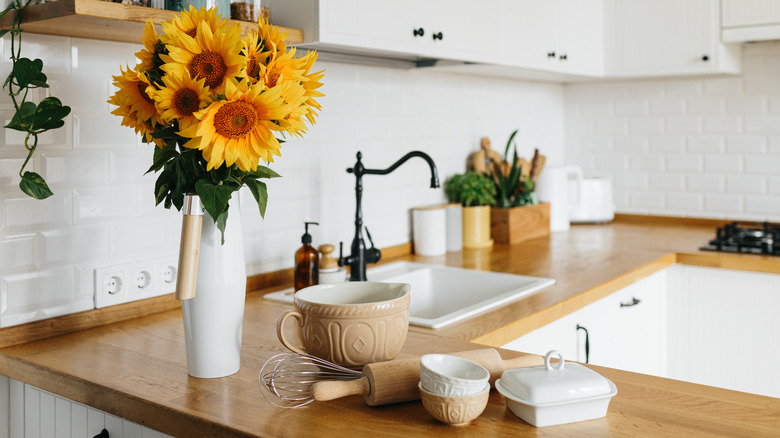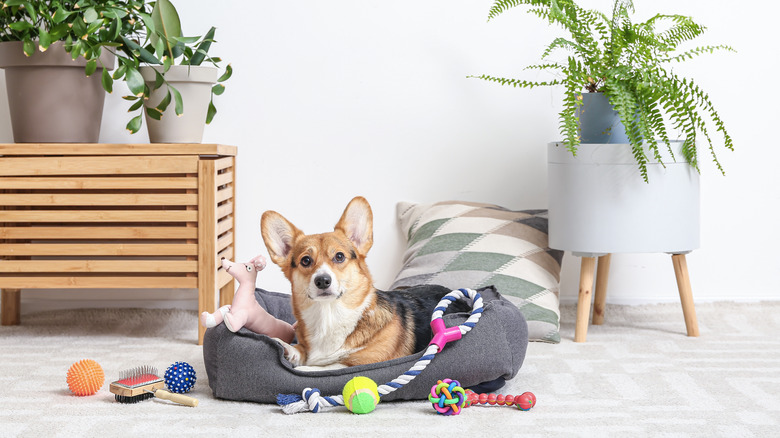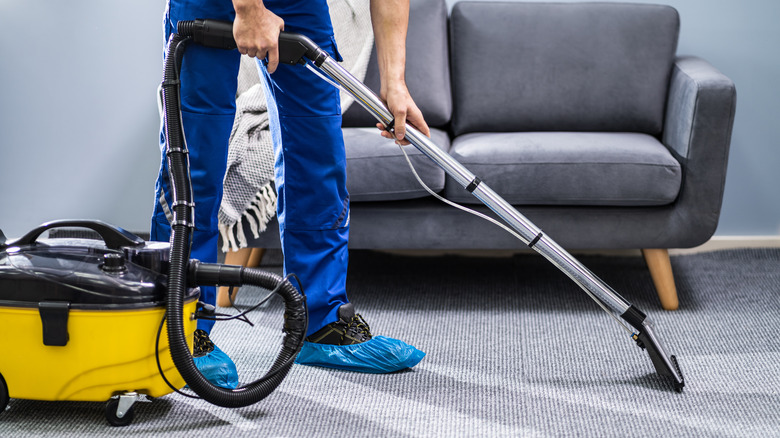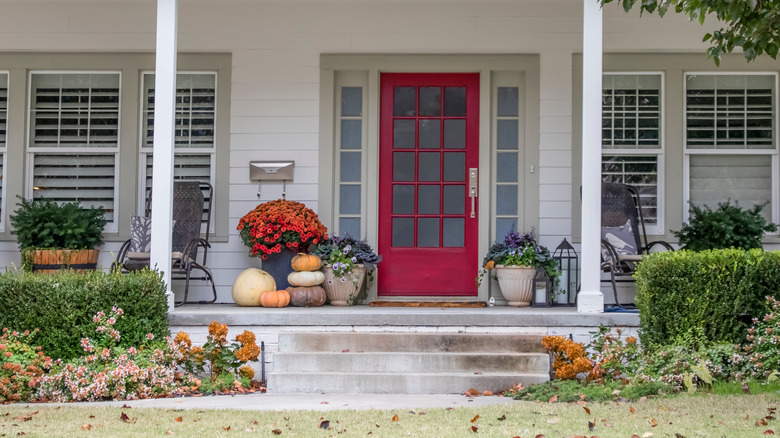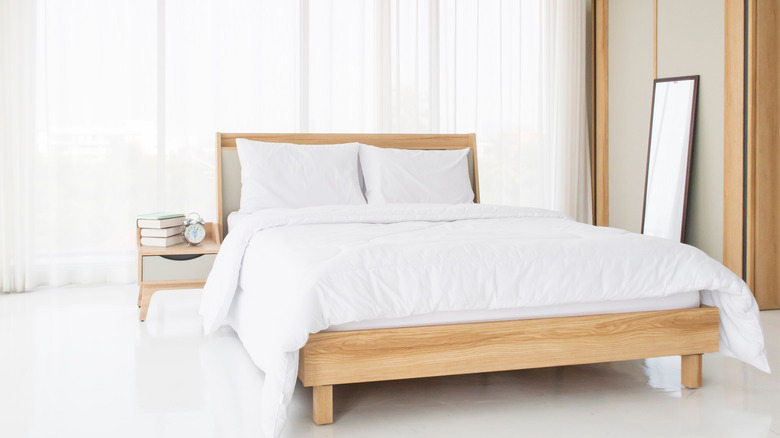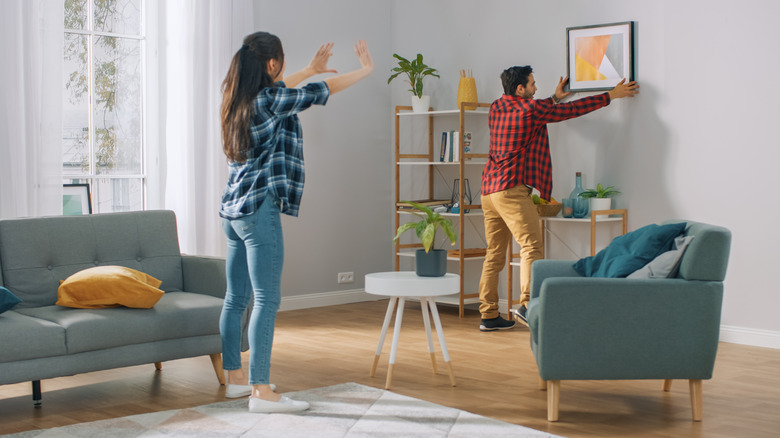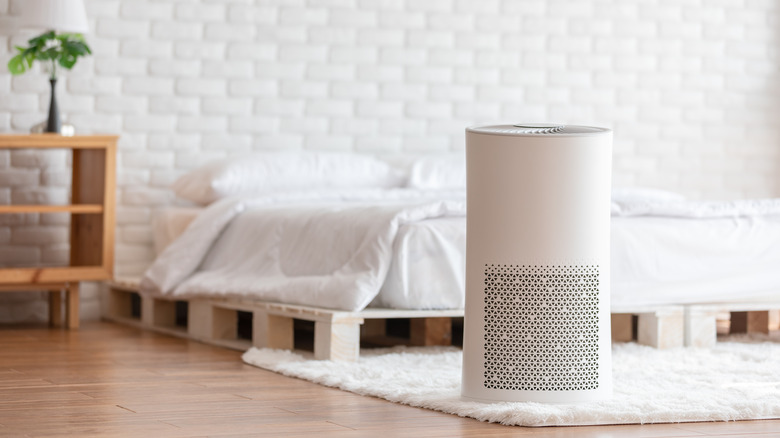How To Stage Your Home Like A Real Estate Agent
Staging is the process of redecorating and rearranging a home to make sure the house appeals to the largest pool of potential buyers, per Travelers. Real estate agents typically encourage you to invest in staging because the process usually earns them a higher commission check (via Greater Boston Real Estate Board). You can hire professional home stagers or ask your real estate agent for help, but these services come with fees.
If you don't want to hire professional help, the great news is that you can stage your home on your own and receive a great return on investment. According to a survey of members by the National Association of Realtors, 33% of buyer's agents agree that a staged home can sell for roughly 1% to 5% more than a home of similar value that isn't staged. Also, no seller's agents reported that viewing a staged home encouraged their clients to offer less money upfront. But staging your home doesn't only give you the potential to receive higher offers. It also significantly decreases the time your home will sit on the market, regardless of market conditions. The survey indicated that 62% of respondents agreed that staged homes sell quicker. That said, it's easy to stage a house on a budget and with little prior experience. Here's how.
Decluttering your home helps buyers imagine themselves in the space
This is the most common advice you are likely to receive if you are interested in staging your home like a real estate agent. As Investopedia reports, decluttering your home has instant, long-lasting, positive effects on the likelihood of your home selling quickly and for a good price. If you remove family photos from the walls and vacation mementos from the shelves, you essentially erase yourself from the home and allow the buyer to imagine how their own belongings would fit into the space.
However, Apartment Therapy recommends taking things a bit further than just removing personal items from a staged home. You should also remove non-personal items that can still congest the space and deter buyers. This includes removing medicine from cabinets, hiding used soaps and toothbrushes, and tidying closets to show their organizing potential. And even though publications like The Fiscal Times advise buyers not to do things like open the fridge during a showing, most attendees will do this anyway, so it's worth considering what they will see inside.
Clean out your closets to add both space and privacy
Potential buyers will take a peek inside each closet they come across. Opening doors and taking a look around is a big part of the home buying process, as buyers are keen to understand how much storage space their potential new home has to offer them. By removing your items from these spaces, you can instantly make the storage room seem more spacious and also maintain your privacy, as fewer visitors will be staring at your shoe collection or winter linens.
However, if you are not in the process of moving already, it can be hard to find a place to store the items you removed during staging. Since the real estate agents of Houlihan Lawrence recommend aiming to remove at least half of all items in each closet, consider renting a temporary storage unit, keeping things in your car, or even housing items at a trusted friend or family member's house. To take things a step further, attempt to keep nothing on the floor of a closet, as even shoes lined up neatly can seem like clutter to some viewers (via Heart & Home Staging).
Correcting little imperfections makes a big difference to buyers
We all have little things around the house that we mean to fix, but our weekends slip away, and we never actually get around to doing them. Things like kitchen cabinets with chipped paint or squeaky bathroom doors might not bother you that much, but they are essential to repair before any house showings. According to the Real Estate Staging Association, all professional stagers are sure to correct even the tiniest of cosmetic imperfections in their client's homes because these small details could make or break the home's sale. That's because they could lower its perceived value. In most buyers' minds, chipped paint is cheap paint, while squeaky doors, burned-out lights, and loose handles indicate a low level of overall maintenance throughout the home.
Ignoring tiny imperfections could also indicate to potential buyers that larger maintenance problems have also been ignored in the home, triggering fears of a possible cracked foundations, leaky pipes, pest control problems, and the like. Professional stagers don't want buyers to assume that they've dressed up a home with bad bones to be something that it's not; they want to accentuate the great features of a beautiful home. The tiny details accomplish this.
Focus on the living room, kitchen, and master suite for the best ROI
Professionally staging an entire home can be difficult, and even if you decide to stage your home like a real estate agent and do things yourself, knowing where to start, and especially where to focus if you have limited resources, can be tricky. But, if you have a tight budget or are short on time, don't worry. The National Association of Realtors reports that during open houses, most visitors spend the most time inspecting the living room, the kitchen, and the master suite to decide whether or not to put in an offer.
The builders at Devonshire Custom Homes emphasize this point, as these spaces tend to be the most lived-in in a home. And if buyers perceive them to be move-in ready, they are more likely to put in an offer. So really, there isn't a need to make sure your laundry room or home office looks perfect. As long as the rest of the house is clean, you can narrow in and focus your staging efforts where they can give you the best return on your investment.
Accentuate awkward spaces within the home
There tend to be spaces in any home that, if not staged, most buyers would have no idea what to do with. They could be an oddly shaped closet, a strangely shaped window nook, or even a room lacking natural light. If you have any strange nooks and crannies in your home, the experts at Houlihan Lawrence recommend staging them as you currently use them to show buyers the area is maximized and not wasted.
The most important thing to do when staging an awkward space is to show buyers the potential of the nook or room. Transform odd corners into mini-offices or storage areas, or if the space is tight and you want to make it seem bigger, use window treatments that are the same color as the walls. This instantly enlarges the room, as contrasting colors will shrink the space (via MHM Professional Staging).
Remove wallpaper as it's too personal
As mentioned, the key to staging your home like a real estate agent is to depersonalize it as much as possible so that it appeals to the broadest range of potential buyers. According to Investopedia, one of the easiest ways to do this is by removing wallpaper and replacing it with plain painted walls. That's because individual styles vary so much that choosing to stage your space by covering bold patterns with neutral tones will help you sell your home faster.
Remember, never paint over wallpaper. Always remove it and paint the actual wall instead, taking care to complete both a base coat and top coat. Nothing can scare away a potential buyer quite like seeing a shoddy paint job at an open house and thinking about all the extra work they would need to complete should they move into the house. This is especially true if your home fell victim to the early 2000s Tuscan decor craze (via Realtor).
Add a personal touch with local flora
A fresh bouquet can really brighten a home showing. The experts at No Vacancy Home Staging recommend using colorful flowers to offset the neutral tones of a perfectly staged home. Locations like coffee and dining tables, breakfast nooks, and even the tops of bedroom dressers can easily become more appealing when accented with flowers. While it might be tempting to use fake potted plants or silk flowers, springing for fresh blooms will leave a better impression on potential buyers.
To go the extra mile, Texas Realtors recommend making the bouquet even more personal by using flora native to your local area or that has some sort of cultural significance. For example, bluebonnets are the state flower of Texas, as are sunflowers in Kansas. If you are selling a home near Washington D.C., adding Japanese cherry blossoms is likely to elicit a positive reaction from buyers. Just remember to keep a close eye on your flowers and replace them as needed because there is one thing worse than using fake flowers to stage a home, and that's using wilted flowers.
Remove all traces of pets
You love Fido, but not all potential homebuyers will. MHM Professional Home Staging says that removing all traces of your furry, feathered, or scaly friends will increase your chances of selling your home quickly. Because there will be a lot of activity in a home during an open house or private showing, it's best to remove animals from the premises during these times and leave them with a trusted friend or family member. You can even check them in as day boarders at a local pet resort. Once they are in safe hands, it's time to go about neutralizing your home.
If you have a dog, you'll need to scan the yard for evidence of their bathroom breaks. If you have a cat, it's best to remove the litter box from the home because even if you can no longer smell it, it's still likely that guests will be able to. Place things like leashes and toys in a cabinet, and be sure to vacuum the house to remove dander. You'll need to check air vents for build-up as well. If a potential buyer has an allergic reaction when inside your home, it's unlikely they will be put in an offer.
Deep clean everything, even your carpets
Even if you don't have pets, deep cleaning your home before a single buyer steps foot inside is an essential part of the staging process, as a well-staged home is a clean home. In fact, 89% of members surveyed by the National Association of Realtors reported deep cleaning had the largest impact on potential buyers' perceptions of a home.
To clean your home like a professional, you'll have to pay attention to the little details, like soap build-up in the sinks and mineral deposits on showerheads. You will also need to clean ceiling fan blades and scrub stained grout between floor tiles (via Rave Home Staging). The best advice for cleaning your home during the staging process is to think back to when you were renting. If you ever had a stickler for a landlord and desperately needed your security deposit back, you likely cleaned every last nook and cranny in your home. Consider potential buyers your stickler of a landlord.
Make first impressions count with updated curb appeal
While most home staging tips tend to focus on the inside of a home, it's important to remember that the outside of the home is often neglected in staging. This is why Investopedia recommends spending time updating your house's curb appeal. If a potential buyer doesn't like the look of your home's outside, it's possible they won't even bother seeing what the inside has to offer.
According to Zillow, things like a well-manicured, healthy lawn and bright flowers in freshly mulched beds are key to catching buyers' attention, as well as basic repairs like a freshly painted front door and refreshed mailbox. If your sidewalk or curb is cracked, put in a request as early as possible with your Homeowner's Association to determine who is responsible for fixing the problem/ If it's the city, it might take a while for the project to be complete (via Classic Construction).
Purchase neutral linens for the home
Even if you make up your bed perfectly with a hospital tuck and chopped pillows, as Crane & Canopy recommends, your grandma's quilt might throw things off. That's because it's too personalized and could polarize the space. Instead, professional stagers tend to replace linens like bedding, towels, and curtains with neutral options for a sleek look during home showings.
While professional home stagers have inventory on hand to create this look, you don't need to panic if you are staging your home independently. This doesn't mean you need to shell out thousands of dollars on expensive linens that aren't to your taste. Instead, buy affordable linens that won't break the bank. The Real Estate Staging Association reports that purchasing sheets and curtains that are less expensive and possibly not as soft to the touch are all a part of the magic of staging. You create a fantasy life for potential buyers as they tour your home. Your bed doesn't need to be soft and inviting in reality. It only needs to look like it is.
Remove and rearrange furniture
If you are concerned that your statement furniture might negatively impact the staging of your home, there isn't a need to worry. While you can rent more plain furniture options to stage your home and return them after the sale, sometimes professionals recommend letting the space speak for itself and having as little furniture as possible, per Moving.com. You want to aim to create as much open, walkable space as possible so those viewing your home can begin to imagine what their own belongings might look like in these rooms.
When arranging furniture, also be careful about placing items too close to entryways, as walking into a room to see the backs of furniture can easily make some buyers feel closed in, according to American Home Shield. To take things further, you can also consider using methods like feng shui to thoughtfully arrange furniture within a room for staging.
Make it smell nice, but don't overpower guests
This Old House host Bob Vila recommends avoiding the popular advice of baking cookies during an open house to make buyers seem at ease. The reason behind his suggestion is that real estate agents have made such a point of promoting this over the years, that most buyers now recognize it for what it is: a sales gimmick. So, while popping cookie dough in the oven during a home showing may be a thing of the past, ensuring your home is free from any bad smells is a must.
Just like with interior design tastes, people's opinions on what smells good differ wildly. Some might find the scent of fresh lavender heavenly, but it might give others a headache. So, other than fresh flowers, Realty Austin recommends removing unpleasant odors and ensuring freshness with less intrusive things like diffusers. Better yet, consider using an air purifier for maximum freshness without any of the potentially polarizing scents (via Amerisleep).
